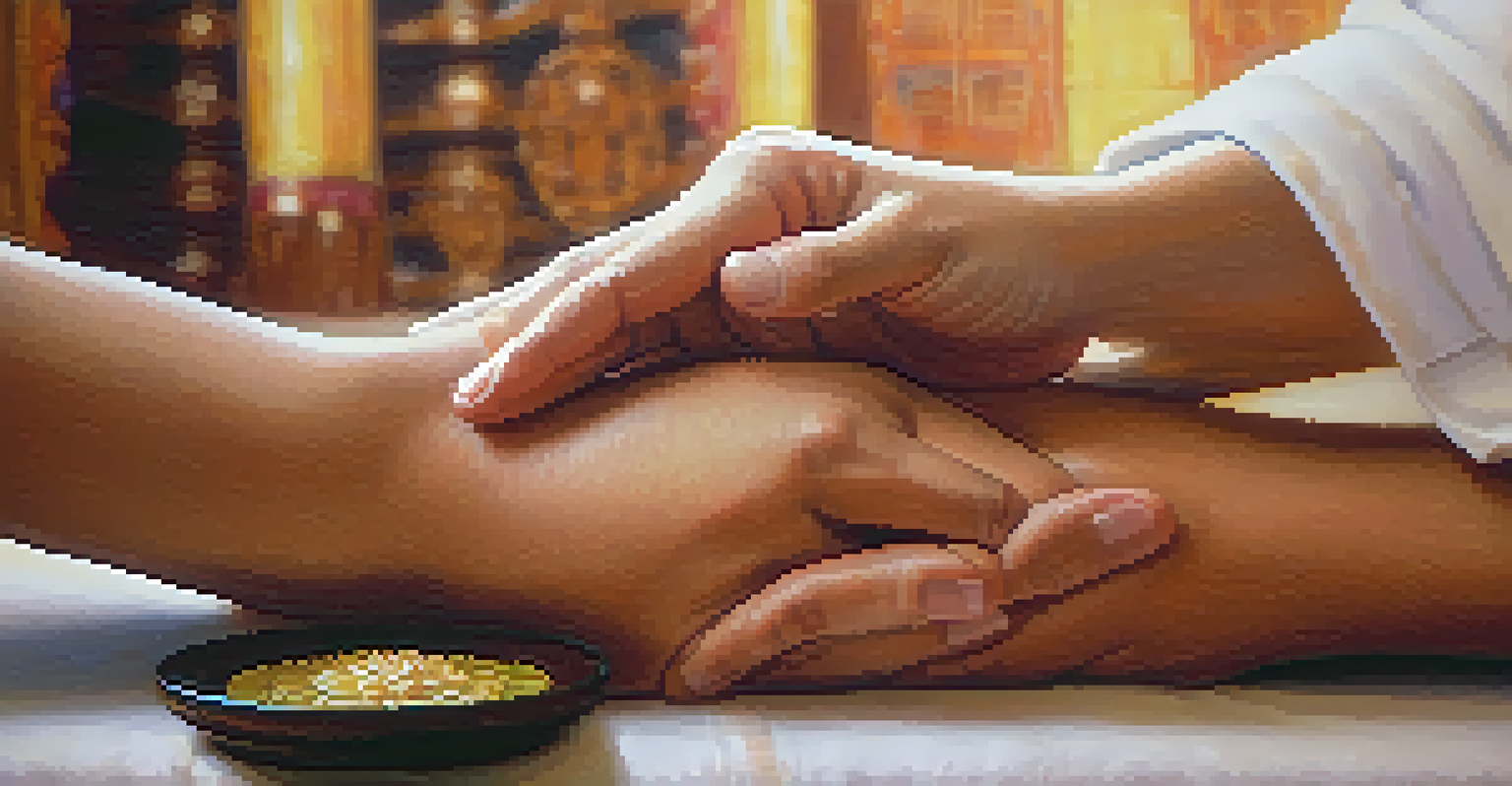Thai Massage: A Holistic Approach to Body Wellness

What is Thai Massage and Its Origins
Thai massage is an ancient healing practice that dates back over 2,500 years. Originating from Thailand, it combines elements of yoga, acupressure, and assisted stretching. This unique approach focuses on energy lines, known as 'Sen,' which are believed to run throughout the body.
Thai massage is a journey, not just a destination; it invites you to reconnect with your mind and body.
Unlike traditional massage, which often involves lying on a table, Thai massage is typically performed on a mat on the floor. This allows the therapist to use their body weight to apply pressure and facilitate stretches. The practice emphasizes holistic wellness, aiming to balance the mind, body, and spirit.
Today, Thai massage is gaining popularity worldwide, appreciated for its ability to promote relaxation, relieve tension, and enhance flexibility. It's not just a treatment; it's an experience that invites individuals to reconnect with their bodies.
The Key Benefits of Thai Massage
One of the standout benefits of Thai massage is its ability to improve flexibility. The gentle stretches involved help to elongate muscles and increase the range of motion, making it particularly beneficial for athletes or those with physically demanding jobs. Imagine feeling as limber as a cat after a good stretch!

Thai massage also enhances circulation, which can lead to improved overall health. As the therapist works through the energy lines, blood flow increases, promoting the delivery of oxygen and nutrients to cells. This boost can make a significant difference in how energized and alert you feel throughout the day.
Benefits of Thai Massage
Thai massage improves flexibility, enhances circulation, and reduces stress, making it a holistic wellness experience.
Moreover, this type of massage is known for its stress-relieving properties. The combination of deep stretching and rhythmic pressure can calm the mind and reduce anxiety. Many people leave a session feeling uplifted and rejuvenated, like they've shed the weight of the world.
Techniques Used in Thai Massage
Thai massage employs various techniques, with stretching being at its core. Therapists use their hands, feet, elbows, and knees to apply pressure and guide clients through stretches. It's like a dance, with each movement flowing seamlessly into the next, creating a harmonious experience.
Flexibility is the key to stability, and Thai massage helps unlock that potential.
Another key technique is acupressure, where specific points on the body are pressed to promote energy flow and alleviate discomfort. This method draws inspiration from traditional Chinese medicine and is believed to release blockages that can lead to pain or tension.
Lastly, breathwork plays a crucial role in Thai massage. Practitioners often encourage clients to synchronize their breathing with the movements, promoting relaxation and enhancing the overall experience. This mindful approach helps to foster a deeper connection between the mind and body.
Preparing for Your First Thai Massage
If you're considering your first Thai massage, it's essential to arrive prepared. Wear loose, comfortable clothing that allows for movement, as you'll be stretching and bending during the session. Think of it as dressing for a relaxed workout rather than a spa day.
Communicate openly with your therapist about any areas of discomfort or tension you wish to address. This dialogue helps them tailor the experience to meet your needs. It's all about creating a personalized journey that leaves you feeling your best.
Unique Techniques Used
Thai massage combines stretching, acupressure, and breathwork to create a dynamic and relaxing experience.
Lastly, approach your session with an open mind and a willingness to relax. Thai massage can be quite different from traditional styles, so embracing the experience can lead to unexpected benefits and a newfound appreciation for holistic wellness.
Post-Massage Care: Maximizing Benefits
After your Thai massage, it's vital to take care of your body to maximize the benefits. Hydration is key; drinking plenty of water helps flush out toxins released during the session. Think of it as giving your body a refreshing drink after a workout.
Gentle stretching at home can also enhance your experience. Incorporating some of the stretches you learned during your session can keep your muscles relaxed and maintain flexibility. It's a great way to continue the positive effects long after you leave the studio.
Lastly, listen to your body. Some may feel energized while others might need time to unwind. Allow yourself to rest and reflect on the experience, letting the calming effects of the massage resonate within you.
Thai Massage vs. Other Massage Types
Thai massage differs significantly from other massage styles, such as Swedish or deep tissue. While Swedish massage focuses on relaxation through gentle strokes, Thai massage emphasizes active stretching and energy flow. It’s more about movement and less about lying still, creating a dynamic interaction.
Deep tissue massage, on the other hand, targets deeper layers of muscle and connective tissue, often using more intense pressure. Thai massage, in contrast, combines pressure with stretches and is often perceived as less aggressive. This makes it an excellent choice for those looking for a gentler yet effective approach.
Choosing a Practitioner
Selecting a certified practitioner is essential for experiencing the authentic benefits of traditional Thai massage.
Ultimately, the best type of massage depends on your personal preferences and goals. If you're seeking a holistic experience that engages the body and mind, Thai massage might just be the perfect fit for you.
Finding the Right Thai Massage Practitioner
Choosing the right practitioner is crucial for a fulfilling Thai massage experience. Look for someone who is certified and has experience in traditional Thai massage techniques. This ensures that you receive the authentic benefits of this ancient practice.
Reading reviews and testimonials can also provide insight into a practitioner’s skill and approach. Personal recommendations from friends or family can be particularly helpful; after all, a little word-of-mouth can go a long way in finding a trusted therapist.

Lastly, don’t hesitate to ask questions during your initial consultation. A good practitioner will be eager to discuss their techniques and approach, helping you feel comfortable and informed before your session begins.